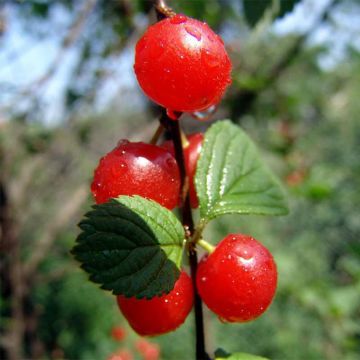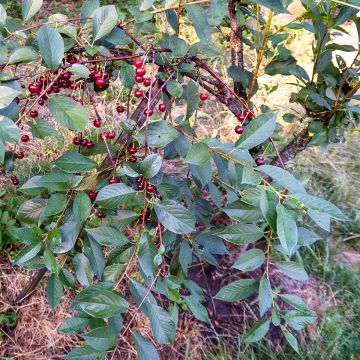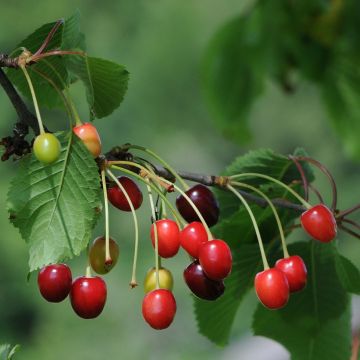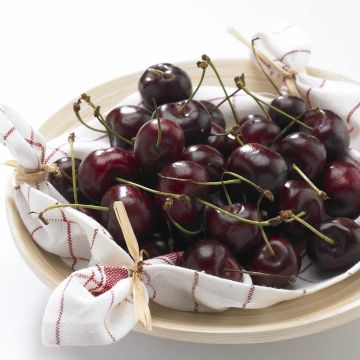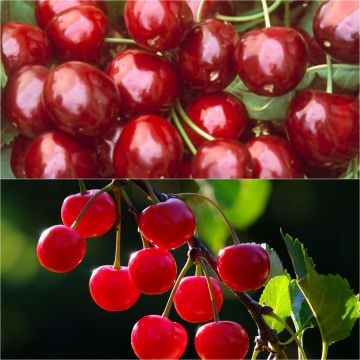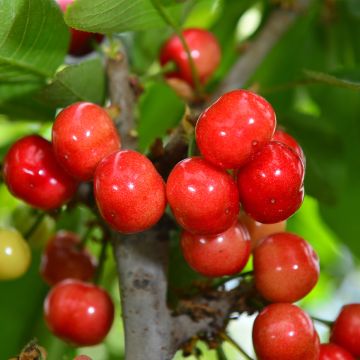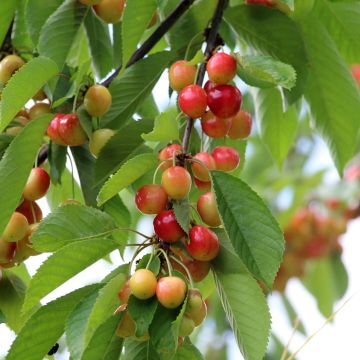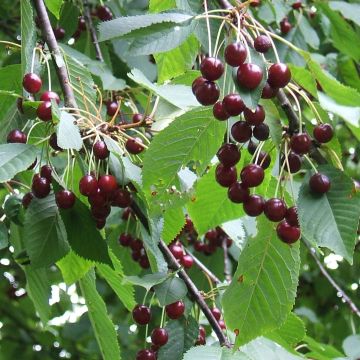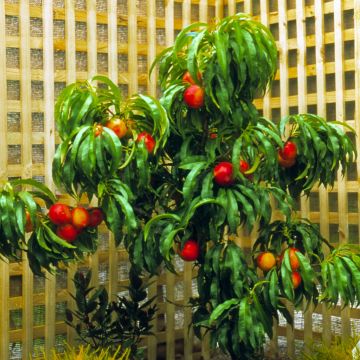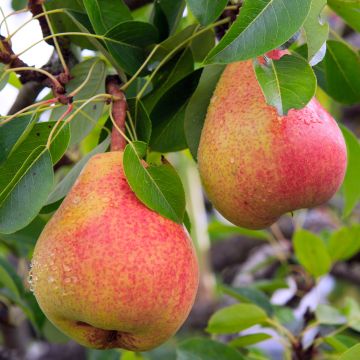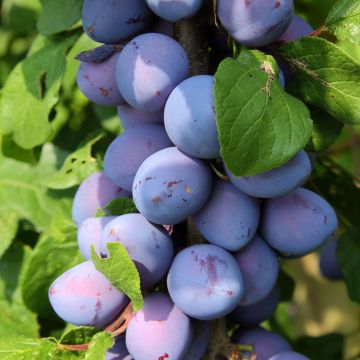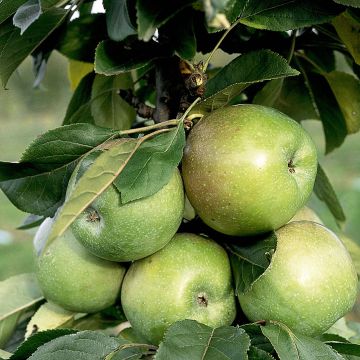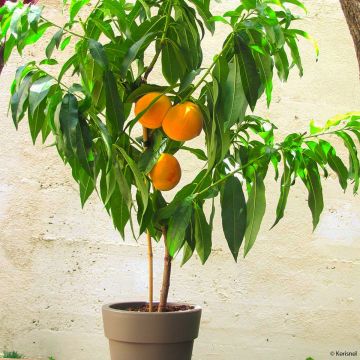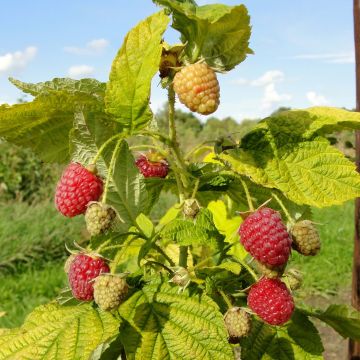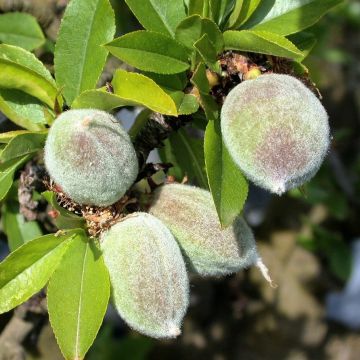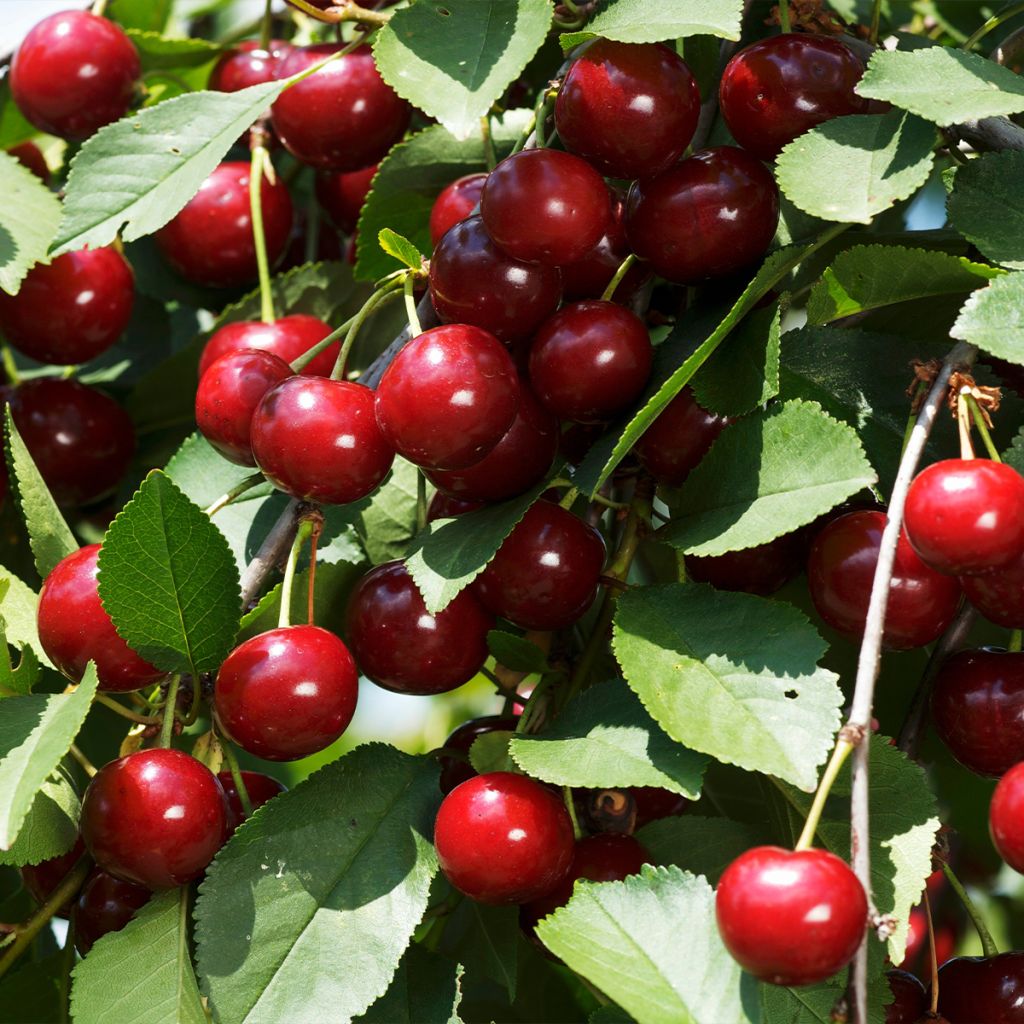

Prunus cerasus Shangai - Tart Cherry
Prunus cerasus Shangai - Tart Cherry
Prunus cerasus Shangai
Sour Cherry, Tart Cherry, Dwarf Cherry, Morello Cherry
The cherry tree arrived entire with the tip broken at 20 cm. I am happy so far with the development of the tree, which has even produced 4 flowers. For now, I am satisfied.
Alain, 08/09/2024
This item cannot be shipped to the selected country
Oversize package delivery charge from €6.90
Delivery to Corse prohibited
More information
Schedule delivery date,
and select date in basket
This plant carries a 6 months recovery warranty
More information
We guarantee the quality of our plants for a full growing cycle, and will replace at our expense any plant that fails to recover under normal climatic and planting conditions.
Oversize package: home delivery by special carrier from €6.90 per order..
Express home delivery from €8.90.
Delivery to Corse prohibited: UE law prohibits the import of this plant from mainland France to Corse as part of the fight against Xylella fastidiosa. Please accept our sincere apologies.
More information

Description
Prunus cerasus 'Shanghai' is a variety of cherry tree well suited for small gardens. With its columnar habit and compact size, it can even be grown in a large container on a terrace. Its decorative pale pink spring flowering evolves into beautiful dark red, crunchy and sweet cherries. It bears fruit after 2 to 3 years of planting, and it is a self-fertile variety that does not need another cherry tree in the garden to bear fruit. Adapting to most soils, tolerant of watering (except during hot periods and in Mediterranean areas), this variety is highly resistant to diseases.
The sour cherry, in Latin Prunus cerasus (also known as Morello cherry), as well as the sweet cherry Prunus avium, are the two main species that have given rise to most of the sweet fruiting cherries cultivated in our gardens. They belong to the Rosaceae family, one of the most important under our latitudes, both for fruit and ornamental gardens, as well as for wild flora. Its alternate and toothed leaves are shiny, dark green, and then take on a beautiful reddish hue in autumn before falling. Cherries are rich in vitamin C, minerals, and trace elements.
This variety 'Shanghai' forms a small tree with a columnar habit, 3 to 4m (10 to 13ft) in height and only 60cm (24in) wide, with fairly rapid growth. In April, it is covered with beautiful pale pink flowers. After pollination by insects, they produce beautiful dark red, sweet and crunchy cherries. Harvesting from this cherry tree is easy due to its shape. The cherries should be picked when ripe, as they do not ripen further after harvest. Shangai is indeed a self-fertile variety, but it benefits from being pollinated by another variety.
This cherry tree can be planted in the majority of garden soils, tolerating acidity and limestone without excess. Once rooted, it is also tolerant of watering, but occasional supplementary watering is always useful, especially during prolonged hot periods. If planted in a container, watering is obligatory, as the growing conditions are much drier than in open ground and the plant cannot access water from the soil at a distance. Highly hardy, this variety withstands -20 °C. Requiring staking, a light pruning to maintain its narrow habit is sufficient.
Adapted to all regions, up to an altitude of 800m (2625ft), the Cherry tree can be planted on a lawn, at the back of a bed, or within an orchard. It is important to be vigilant in spring, as the flowering is very sensitive to frost (damage occurs from -2 °C). Thanks to its columnar shape, this variety is very easy to protect in this case using a non-woven fleece cover of 30g/m² to wrap around the foliage. Due to its compact size, it is possible to plant multiple trees spaced only 80cm (32in) to 1m (3ft) apart. By selecting dwarf fruiting varieties, it is also possible to create an orchard in a small area. The dwarf peach tree 'Amber Pix Zee' will be a perfect companion, as well as the dwarf apple tree 'Garden Sun Red'.
Report an error about the product description
Prunus cerasus Shangai - Tart Cherry in pictures
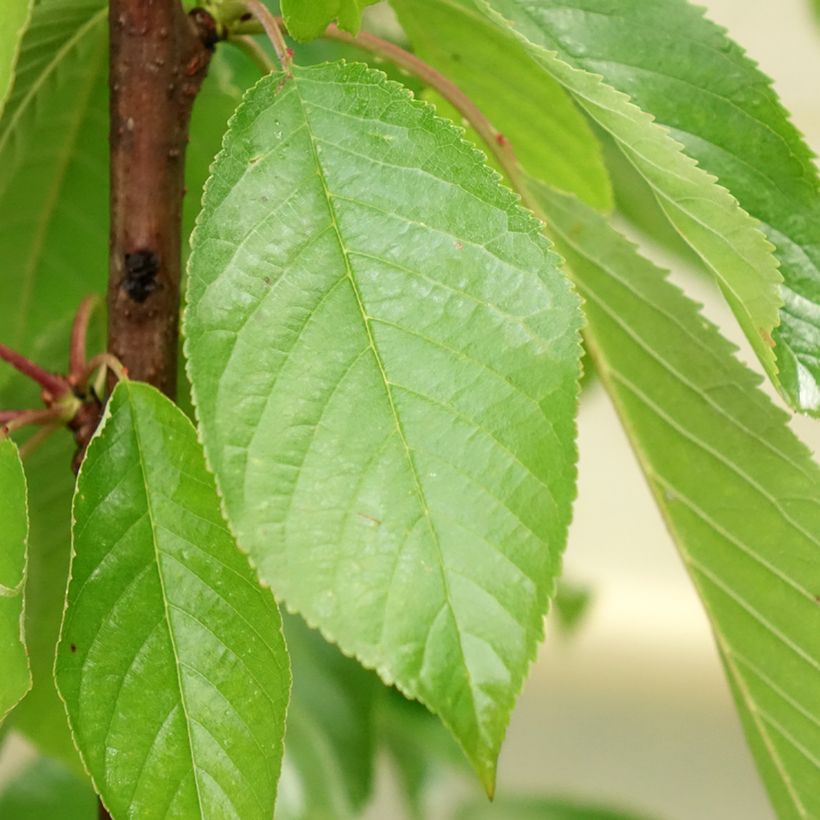

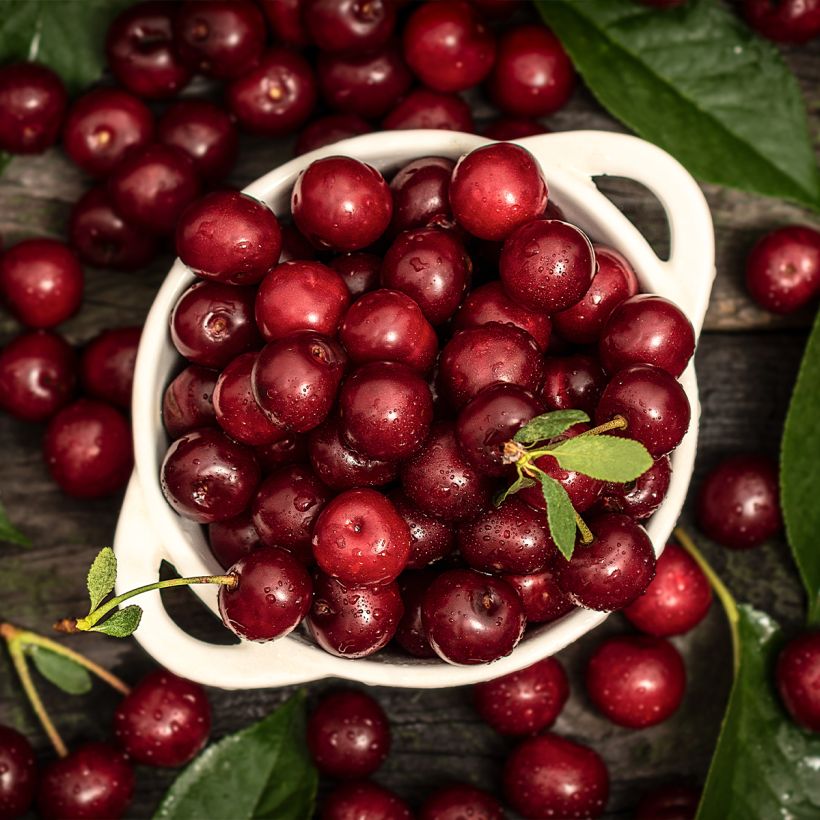

Plant habit
Fruit
Flowering
Foliage
Botanical data
Prunus
cerasus
Shangai
Rosaceae
Sour Cherry, Tart Cherry, Dwarf Cherry, Morello Cherry
Cultivar or hybrid
Other Cherry trees
Planting and care
Easy to grow, the Cherry tree thrives in all types of soil, whether acidic or chalky. It prefers moist and light soils, and dislikes heavy and clayey ones. Choose a sunny location. In order to limit the risks of late frost on the flowers, it is recommended to plant the Cherry tree in a sheltered position, facing west and protected from cold winds in regions that experience spring frosts. Planting is preferably done in autumn.
Loosen the soil deeply, remove rocks and unwanted weeds. Add some sand to improve drainage. Dig a hole 4 to 5 times the size of the root ball. Make sure to separate the subsoil and the topsoil. Mix crushed horn or well-rotted compost or potting soil with the subsoil and pour this mixture into the planting hole. Install a stake, then place the root ball, cover with the topsoil and firm it down well. Water generously. Attach the stake to the young plant, crossing the tie in the shape of an 8, without tightening around the trunk to allow it to grow thicker without being strangled (to be monitored over the years).
During cultivation, watering is not essential but necessary in case of high temperatures, especially in Mediterranean regions. If you are growing 'Shangai' in a container, on the other hand, you will need to water regularly as your tree will not be able to draw from the soil as it would in open ground. Mulch at the base to retain freshness in summer. Protect your harvest by installing a bird net. In case of aphid attack, spray diluted black soap in water.
Planting period
Intended location
Care
-
, onOrder confirmed
Reply from on Promesse de fleurs
Fruit trees for small gardens
Haven't found what you were looking for?
Hardiness is the lowest winter temperature a plant can endure without suffering serious damage or even dying. However, hardiness is affected by location (a sheltered area, such as a patio), protection (winter cover) and soil type (hardiness is improved by well-drained soil).

Photo Sharing Terms & Conditions
In order to encourage gardeners to interact and share their experiences, Promesse de fleurs offers various media enabling content to be uploaded onto its Site - in particular via the ‘Photo sharing’ module.
The User agrees to refrain from:
- Posting any content that is illegal, prejudicial, insulting, racist, inciteful to hatred, revisionist, contrary to public decency, that infringes on privacy or on the privacy rights of third parties, in particular the publicity rights of persons and goods, intellectual property rights, or the right to privacy.
- Submitting content on behalf of a third party;
- Impersonate the identity of a third party and/or publish any personal information about a third party;
In general, the User undertakes to refrain from any unethical behaviour.
All Content (in particular text, comments, files, images, photos, videos, creative works, etc.), which may be subject to property or intellectual property rights, image or other private rights, shall remain the property of the User, subject to the limited rights granted by the terms of the licence granted by Promesse de fleurs as stated below. Users are at liberty to publish or not to publish such Content on the Site, notably via the ‘Photo Sharing’ facility, and accept that this Content shall be made public and freely accessible, notably on the Internet.
Users further acknowledge, undertake to have ,and guarantee that they hold all necessary rights and permissions to publish such material on the Site, in particular with regard to the legislation in force pertaining to any privacy, property, intellectual property, image, or contractual rights, or rights of any other nature. By publishing such Content on the Site, Users acknowledge accepting full liability as publishers of the Content within the meaning of the law, and grant Promesse de fleurs, free of charge, an inclusive, worldwide licence for the said Content for the entire duration of its publication, including all reproduction, representation, up/downloading, displaying, performing, transmission, and storage rights.
Users also grant permission for their name to be linked to the Content and accept that this link may not always be made available.
By engaging in posting material, Users consent to their Content becoming automatically accessible on the Internet, in particular on other sites and/or blogs and/or web pages of the Promesse de fleurs site, including in particular social pages and the Promesse de fleurs catalogue.
Users may secure the removal of entrusted content free of charge by issuing a simple request via our contact form.
The flowering period indicated on our website applies to countries and regions located in USDA zone 8 (France, the United Kingdom, Ireland, the Netherlands, etc.)
It will vary according to where you live:
- In zones 9 to 10 (Italy, Spain, Greece, etc.), flowering will occur about 2 to 4 weeks earlier.
- In zones 6 to 7 (Germany, Poland, Slovenia, and lower mountainous regions), flowering will be delayed by 2 to 3 weeks.
- In zone 5 (Central Europe, Scandinavia), blooming will be delayed by 3 to 5 weeks.
In temperate climates, pruning of spring-flowering shrubs (forsythia, spireas, etc.) should be done just after flowering.
Pruning of summer-flowering shrubs (Indian Lilac, Perovskia, etc.) can be done in winter or spring.
In cold regions as well as with frost-sensitive plants, avoid pruning too early when severe frosts may still occur.
The planting period indicated on our website applies to countries and regions located in USDA zone 8 (France, United Kingdom, Ireland, Netherlands).
It will vary according to where you live:
- In Mediterranean zones (Marseille, Madrid, Milan, etc.), autumn and winter are the best planting periods.
- In continental zones (Strasbourg, Munich, Vienna, etc.), delay planting by 2 to 3 weeks in spring and bring it forward by 2 to 4 weeks in autumn.
- In mountainous regions (the Alps, Pyrenees, Carpathians, etc.), it is best to plant in late spring (May-June) or late summer (August-September).
The harvesting period indicated on our website applies to countries and regions in USDA zone 8 (France, England, Ireland, the Netherlands).
In colder areas (Scandinavia, Poland, Austria...) fruit and vegetable harvests are likely to be delayed by 3-4 weeks.
In warmer areas (Italy, Spain, Greece, etc.), harvesting will probably take place earlier, depending on weather conditions.
The sowing periods indicated on our website apply to countries and regions within USDA Zone 8 (France, UK, Ireland, Netherlands).
In colder areas (Scandinavia, Poland, Austria...), delay any outdoor sowing by 3-4 weeks, or sow under glass.
In warmer climes (Italy, Spain, Greece, etc.), bring outdoor sowing forward by a few weeks.


































